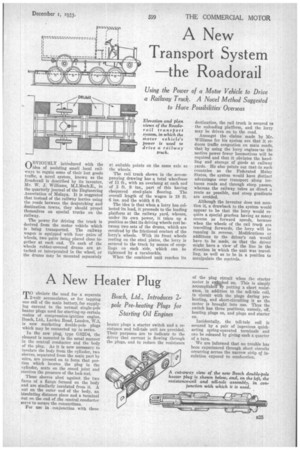A New Transport System the Roadorail
Page 43

If you've noticed an error in this article please click here to report it so we can fix it.
OOBVIOUSLY introduced with the of assisting small local railways to regain some of their lost goods traffic, a novel system, known as the Roadorail is described by its inventor, Mr. W. J. Williams, M.I.Mech.E., in the quarterly journal of the Engineering Association of Malaya. It is suggested that instead of the railway lorries using the roads between the despatching and destination towns, they should propel themselves on special trucks on the railway.
The power for driving the truck is derived from the motor vehicle which is being transported. The railway wagon is equipped with four pairs of wheels, two pairs being placed close together at each end. To each of the wheels rubber-covered drums are attached or incorporated in the wheel, or the drums may be mounted separately at suitable points on the same axle as the wheels.
The rail truck shown in the accompanying drawing has a total wheelbase of II ft., with an overhang at each end of 3 ft. 9 ins., part of this having chequered steel-plate flooring. The overall length of the wagon is 18 ft. 6 ins, and the width 8 ft.
The idea is that when a lorry has collected its load, it proceeds to the loading platform at the railway yard, whence, under its own power, it takes up a position so that its driving wheels rest between two sets of the drums, which are revolved by the frictional contact of the lorry's wheels. With its front wheels resting on the steel plates, the lorry is secured to the truck by means of couplings on each side, which can be tightened by a turnbuckle.
When the combined unit reaches its destination, the rail truck is secured to the unloading platfbrm, and the lorry may be driven on to the road.
Amongst the claims • made by Mr. Williams for his system are that it reduces traffic congestion on main roads, that by using the lorry engines fas the motive power fewer locomotives will be required and that it obviates the handling and storage of goods at railway yards. He also points out thatin such countries as the Federated Malay States, the system would have distinct advantages over transport along tortuous roads and through steep passes, whereas the railway takes as direct a route as possible, and steep gradients are avoided, Although the inventor does not mention it, a drawback to the system would appear to be that the lorry would require a special gearbox having as many reverse as forward speeds, because when the wheels of the rail truck are travelling forwards, the lorry will be running in reverse. Modifications or additions to the driver's cab would have to be made, so that the driver might have a view of the line in the direction in which the unit was travelling, as well as to be in a position to manipulate the controls.




































































































